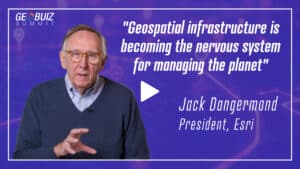After success in Space Technology, will Geospatial & Mapping Technology be the next frontier for India?
India will soon host the G20 leaders’ summit in New Delhi for the first-time. The G20, or Group of Twenty, is an intergovernmental forum of the world’s 20 major developed and developing economies; it is the premier forum for international economic cooperation. Integral to the theme of India’s G20 presidency – One Earth, One Family, One Future – is the principle of “data for development”, as announced by Prime Minister (PM) Narendra Modi at the closing session of the G20 summit in Bali last year.
The Chandrayaan landing on the moon is a huge success of India’s vision and focus on space technology. The program’s success is an excellent showcase of how countries from around the world can collaborate to exchange data and technology for success and growth.
However, the effective use of data requires more than just collecting and analysing it. For the G20 to truly move the needle on conversations around global sustainable growth, it must discuss turning data – including geospatial data – into intelligence and leveraging it for India to stay competitive.
Embarking on a journey to foster national innovation with data
India is at the cusp of a data revolution. During the Union Budget 2023-2024 held earlier this year, Finance Minister Nirmala Sitharaman unveiled the formation of a National Data Governance Policy (NGDP) aimed at providing academia and start-ups with anonymised data. Under this policy, the Indian government can sell anonymised public data sets – not containing personal information – to researchers, start-ups and companies.
The same applies to geospatial and location data. Speaking at the inaugural session of the United Nations World Geospatial Information Congress (UNWGIC) in India last October, PM Modi said geospatial data and technology is a tool for inclusion in India, and that it has helped drive progress.
Geospatial and mapping technologies have become a common thread to optimise and bring in efficiencies, including using these technologies to drive economic growth across businesses. The use of location data is already transforming supply chains from reactive to predictive, and enabling autonomous and electric vehicle development to make big strides.
The G20 is an ideal platform to put together a common Geospatial and Mapping Program that can further drive adoption of these technologies and data sharing among member countries. It will help in sharing knowledge and technology transfer within G20 Countries.
Opportunity to lead the world with a common geospatial and mapping program
India strives to be a world leader in the global geospatial space. By liberalising the use of geospatial data under the National Geospatial Policy in December 2022, the country is ensuring more local players to be included in the field, and in turn increase the competitiveness of Indian companies in the global geospatial market.
Enhancing the country’s geospatial readiness and data quality is fundamental for the realisation of a ‘Digital India’, and the Indian government has emphasised on “Make in India, Make for World” – focusing on locally available data, maps, and geospatial data.
With a common Geospatial and Mapping Program, organizations from G20 countries will be able to work in tandem with each other to build state-of-the-art solutions. This will not only ensure success and growth of economy but also create a common geospatial data exchange platform between G20 countries.
Like in space technology, India should now take the lead to open India’s Geospatial Policy regulations so that geospatial and mapping players from around the world can collect, process, publish, and host high accuracy and high-definition maps. it’s important to understand that maps today are sophisticated with widespread beneficial implications across many different verticals. Stronger collaboration with more established players from G20 countries would most certainly help boost the Indian economy.
For example, Geospatial and Mapping players from across G20 member countries could partner with universities, educational institutions, and the local communities to help realise the true value of this technology and equip various sectors of the economy with geospatial skills. In the long term, this will add more value and set up a future-ready geospatial industry in India.
Showcasing India’s digital future
Data is the backbone of development in the digital era. Throughout the past few years, India has shown the world its progress in leveraging data to revolutionise India. We’ve seen this applied to the country’s pandemic response, efforts towards greater financial inclusion such as the country’s Unified Payment Interface (UPI), healthcare, and more.
With India’s current G20 presidency, this is an opportunity for the country to demonstrate how the intelligent use of geospatial data is beneficial to sustainable growth. A common Geospatial & Mapping program with right governance model would play a vital role for economic growth in G20 countries and help further drive the theme of G20 Summit – One Earth, One Family, One Future!
Disclaimer: Views Expressed are Author's Own. Geospatial World May or May Not Endorse it








